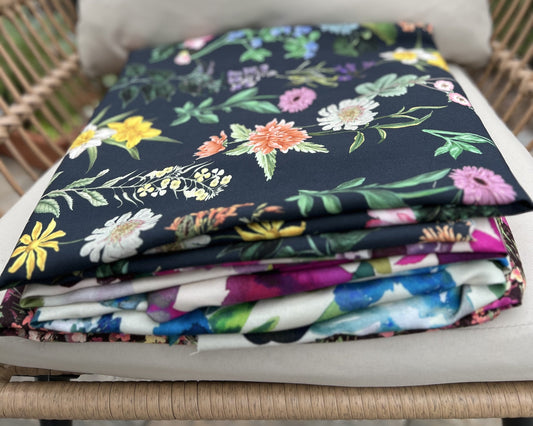This article will serve as a kind of guide to the series on wool, so it seems natural that it should dispel the doubts, uncertainties, and fears that arise when you first think about sewing with wool.
Top 5 reactions of people who haven't had the chance to know and love wool yet are:
- "It bites!"
- "You can't wash this!"
- "The moths will eat them!"
- "It's only for winter."
- "It's for the sweater."
Therefore…
"Wool? It bites!"
It's a big generalization because "they scratch" varieties of wool with high coarseness and thick hair. Sheep come in a multitude of varieties that differ not only in appearance but also in the type of fleece. One cannot fail to mention the noble Merinos, which have soft and fine wool with excellent thermal parameters. When looking for the right knit or wool fabric, we must define our needs and requirements. For clothing intended for constant contact with the body, more specifically the skin (especially children's), the best choice will be Merino wool (also called merino), as it is the softest sheep wool. Varieties of Merino sheep, and even individual animals, differ in the quality of their wool, so among them, we will also find softer wools and those that are less delicate. For outerwear or clothing with a lining, we can opt for wool with lower fiber parameters, so let's not dismiss less delicate wools.
"We have a field here for a good fabric seller, who will propose the right material depending on the expectations and application."
A brief mention should be made of the allergy to sheep wool, more specifically the lanolin contained in it, which can cause skin irritation even with the softest sheep wool yarn. In this case, it is worth looking for an alternative, which often turns out to be cashmere, that is, the wool from a special breed of goats, or alpaca wool. Both fibers contain negligible amounts of lanolin.
And finally - let's love the scratching of wool. Coarse wool massages the skin, improving its blood circulation, and thus takes care of its nourishment and condition. Let's give a chance to slightly scratching wool. Our skin largely gets used to the stimuli it constantly receives. Who among us remembers the once-popular massaging slippers with protrusions? Something that initially felt like walking on gravel eventually became a pleasant massage.
"Wool? You can't wash that!"
"Ready-made woolen clothing, especially outerwear, often has dry cleaning as a care instruction. Manufacturers often take this precaution somewhat excessively to protect themselves from potential complaints arising from improper garment care."
Sewing independently gives us a greater scope for creativity. We can use wool with the already common "superwash" finish or dare to test the purchased fabric. For this purpose, we cut a piece of fabric at least 10×10 cm in size and wash it. After it is completely dry, we check whether its size or quality has changed. If the wool has retained its size and structure, we will be able to successfully wash the garments made from it.
We wash wool by hand or on a wool washing program (it is best to test your washing machine first) using a detergent specifically designed for this purpose (we do not wash wool with standard powders/liquids/capsules for washing!).
We often fear the recommended hand washing, but it's completely unnecessary. Hand washing wool involves soaking it in water with wool detergent, then gently squeezing, rinsing, pressing (not wringing!) out excess water, and leaving it to dry. This process is actually not very demanding, and considering that wool is antistatic, meaning it does not attract dust and absorbs dirt poorly, as well as not retaining odors, we wash wool clothes less frequently than the rest of our wardrobe. We also don't need to worry about the lack of spinning or wringing, as wool dries faster than other natural materials (cotton, linen, viscose).
"Wool? Moths will eat it!"
Woolen clothes are extremely durable and, unlike cotton, they age slowly, and they do not shrink, fade, or gray. The only enemy of wool is moths (less often fur beetles). However, we can successfully protect our wool from moths, and our grandmothers and great-grandmothers knew how to do this perfectly and used the same woolen clothes for years.
Moths are sensitive insects; they dislike drafts, sunlight, and strong scents. Therefore, wool should not be stored in stuffy places, wardrobes should be aired regularly, and woolen clothing should be taken out and aired on sunny days. A good practice is to simultaneously wipe the inside of the wardrobe with water and vinegar. We store wool alongside strong scents. Not only lavender is a moth repellent. In addition to it, we can successfully use bay leaves, mint, or patchouli, and even the once commonly used common bog herb. The effectiveness of mothballs, which leave an unpleasant smell, cannot be denied, as they seem to repel people as effectively as pests. A popular and effective method is also to place a strongly scented soap bar among woolen clothes.
Of course, manufacturers of insect control products have not remained indifferent to the problem of wool pests and offer hangers or cards that not only repel but also kill moths. So we have a choice between natural and chemical agents.
I want to raise awareness about using moth traps. Let's not use them preventively! They contain pheromones that attract moths even from a distance. So if we leave such a trap for a longer time, the moths will feel invited, and any ventilation grilles or open windows will be like the wide-open doors of the best restaurant.
We use traps in two cases:
- When we want to check if we have a moth invasion. We close the windows, secure the ventilation grilles, and leave a trap in a place where we expect moths for a day or two. Then we promptly remove the trap!
- When we are sure that we have a moth invasion and as a support for other methods, we want to quickly reduce the number of moths in the apartment. We also secure ventilation openings and try to avoid prolonged airing while we are using the trap.
"Wool? That's only for winter."
Wool is the undisputed queen of winter, as it warms us by utilizing the heat of our body. It is a "living" fiber that, like our hair, reacts to humidity and the temperature of the environment. This unique miracle of nature, due to its specific structure, traps air pockets that insulate us from the surrounding temperature, whether it is high or low. I will use a simple comparison to double-glazed windows, which, thanks to the layer of air sealed between the panes, perfectly protect the apartment from heat loss in winter or the heat outside in summer. Of course, we are not talking about the situation when the sun shines through the window and heats the room, because the window, unlike wool, is a poor barrier to sunlight. Wool, on the other hand, has a natural UV filter, and merino wool leads the way with a UPF exceeding 50 (this means that for every 50 units of light that reach the wool, it will allow through at most 1 unit, thus blocking at least 98% of both UVA and UVB radiation). Most ordinary clothing has a UPF of 6 (according to the American magazine Consumer Reports).
Wool simultaneously wonderfully absorbs and evaporates water, so we do not have to fear the penetrating cold of rainy mornings or "steaming" in sweaty clothing when the skin is practically begging for access to air.
"Wool? That's only for sweaters."
Many people still, upon hearing the word "wool," imagine yarn, and although yarns with a high wool content are the top of the top in the world of yarns, more of the world's production of sheep fleece goes to fabric and knitwear manufacturers, and then to sewing factories or to our home sewing machines. Wool is not just yarn, but also woolen fabrics and woolen knits. It's not just woolen sweaters; it's also the best woolen suits, wool thermal clothing, woolen children's clothes, woolen dresses, woolen shirts, or high-end woolen skirts and wool clothing from the world's fashion runways.
"If this first article has managed to interest you in wool, then this series will certainly become an interesting journey into the world of this extraordinary fiber."
Author: Kamila Muszarska-Iwaniczko




